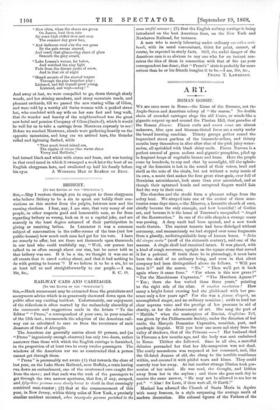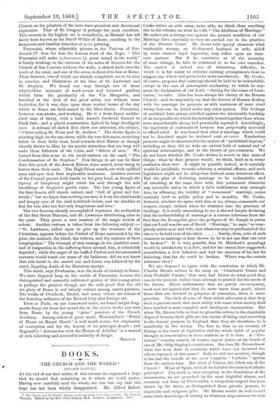ART.
ROMAN GOSSIP.
WE are once more in Rome—the Rome of the Romans, not the Anglo-Saxon and American colony of "the season." No double chain of crowded carriages clogs the old Corso, or winds like a gigantic serpent up and around the Pincian Hill, that paradise of the Roman fie/near. Flaxen curls and aurea coma are almost unknown, blue eyes and blossom-tinted faces are a rarity under the broad burning sunshine. Thirsty groups gather round the improvized street gardens of the lemonade-sellers, and thirsty mouths bury themselves in slice after slice of the pink juicy water- melon, all sprinkled with black shiny seeds. Piazza Navona is a perfect arsenal of green melons and gigantic pumpkins, piled up in fragrant heaps of vegetable bronze and brass. Here the people come by hundreds, to sup and chat by moonlight, till the splash- ing of the fountain is lost in the sound of their voices, loud and shrill as the note of the cicala, but not without a noisy music of its own, a music that makes the four great river-gods, ever full of Berninian astonishment, look more than ever astonished, and as though their upturned hands and outspread fingers would fain find the way to their ears.
The churches and the studii form a pleasant refuge from the sultry heat. We strayed into one of the coolest of these sanc- tuaries some days since,—the Minerva, a favourite church of ours, chiefly because the only example, and how beautiful ! of Gothic art, and because it is the home of Tenerani's unequalled "Angel of the Resurrection." In one of the side chapels a strange scene was passing. A deep vault had been opened, and a new tomb made therein. The ancient tenants had been dislodged without ceremony, and unconsciously we had stepped over some fragments from a ghastly, undistinguishable heap of human bones. "Roba del cinque cento" (stuff of the sixteenth century), said one of the masons. A single skull had remained intact. It was placed, with a kind of rough reverence, upright on the square stone that served it for a pedestal. If truth there be in phrenology, it must have been the skull of no ordinary being, and even in that silent company had been distinguished above its fellows. "Will you have it?" said the mason. "No." "Then we'll put it back again where it came from." "For whom is this new grave ?" "For the Marchioness Capranica." "The Marchesa Agnese ?" " Yes ; there she has waited these three years," pointing to the right side of the altar. 0 vanitas vanitatum ! How many a bright festal evening had she gladdened with her pre- sence only a few years ago, For she was a femme d'esprit, an accomplished singer, and no ordinary musician ; swift to lend her clear soprano voice and the prestige of her presence in aid of charity, or for the advancement of art. She sang the part of " Matilda " when the masterpiece of Rossini, Guylielmo Tell, was given by the Philharmonic Society, under the direction of her uncle, the Marquis Domenico Capranica, musician, poet, and quadruple linguist. Will you hear one more sad story from the valley of shadows, that of the Princess —? Her husband died in Florence a few months ago, and the body was sent embalmed to Rome. Thither she followed. Sane in all else, a merciful delusion persuaded her that her life-companion was not dead. The costly mausoleum was reopened at her command, and, like the ill-fated Jeanne of old, she clung to the terrible semblance within, and covered it with pitiful tears and kisses. They could scarcely tear her away. At last another strange illusion took pos- session of her mind. He was mad, she thought, and hidden away from' her in the asylum ; and there she goes each day to receive the same answer, "He may not be allowed to see her as yet." " Alas ! for Love, if thou wert all, 0 Earth !"
Mariani has adorned the Church of Santa Maria in Aquiro with many frescoes, in a style surpassing the average merit of modern decoration. His colossal figures of the Fathers of the
Church on the pilasters of the nave have grandeur and devotional expression. That of St. Gregory is perhaps the most excellent. This success in the highest art is remarkable, as Mariani has till lately been known as the David Wilkie of Rome, excelling in the humorous and familiar branches of genre painting.
Fracassini, whose admirable picture in the Vatican of Fer- dinand IV. won for him the famous word of the Pope, "This Fracassini will make a fracassone [a great noise] in the world," is busily working on the cartoons of his series of frescoes for the Church of San Lorenzo without the walls, a church built over the tomb of the saint, and one of the seven dedicated to him at Rome. These frescoes, two of which are already completed, are to be nine in number, and illustrative of the lives of St. Lawrence and St Stephen. We found our way through one of those labyrinthine mixtures of work-rooms and terraced gardens which form the peculiarity of the Via Margarita, and knocked at the door of the great artist, not without some hesitation, for it was close upon those central hours of the day which in Rome are held sacred to the Diva Siesta. Fracassini, "however, was awake, and working. He is a fresh-faced, middle- sized man of thirty, with a bald, smooth forehead, framed in black hair ; and a placid countenance, lighted by large intelligent eyes. A colossal oil sketch first drew our attention, the subject, "Christ calling St. Peter and St. Andrew." The divine figure is standing high on the sea-shore, while the two fishermen, crouching below in their little boat, bend towards their Master as though already drawn to Him by the mystic attraction that ere long will make them followers of the Cross and "fishers of men." We turned from this scene to the small cartoon on the easel, "The Condemnation of St. Stephen." Few things in art can be finer than this synod of the Jewish Elders, some seated, some rising in horror from their seats. The High Priest stands out with uplifted arms and eyes that flash implacable anathema. Another ancient of the Council presses both hands to his grey head, as though the leprosy of blasphemy might reach his soul through the soft breathings of Stephen's gentle voice. The fair young figure of the first deacon still stands unhurt, and "full of grace and for- titude ;" but we know that nothing can save it from the cruel hands and hungry eyes of the mad multitude below, and we shudder in fear for him who can feel only forgiveness and love !
The two frescoes already accomplished represent the ordination of the first Seven Deacons, and St. Lawrence distributing alms to the poor. They prove a rare mastery of the magic secrets of colour. Another cartoon is taken from the following subject :— " St. Lawrence, called upon to give up the treasures of the Christians, appears before the Prefect of Rome surrounded by the poor, the maimed, the blind, the widows, and the orphans of their congregation." The triumph of true courage in the youthful saint, and of resignation in the suffering faces around him, is admirably depicted ; while the anger of the baffled Prefect and his astonished servants would touch our sense of the ludicrous, did we not know that this insult to the sacred .axe aud fasces was followed by the cruel, lingering death of the illustrious martyr.
This death, says Prudeutius, was the death of idolatry in Rome. We have lingered long in the studio of Fracassini, because the distinguished and earnestly cultivated genius of this young artist is perhaps the greatest though not the only proof that the old art glory of Rome is not utterly extinct among native painters. The works of Overbeck, Riedel, and many others are tokens of the fostering influence of the Eternal City over foreign art.
Even at Paris, on our homeward route, we found bright frag- ments flung out from her sacred fire in the clever works just sent from Rome by the young " prize " painters of the French Academy. Among others of great merit, Monchablon's "Burial of Moses on Mount Horeb" is well worth notice, for originality of conception and for the beauty of its principal .heads; and Regnault's " Autornedon with the Horses of Achilles" is a marvel of rich colouring and successful audacity of design.































 Previous page
Previous page